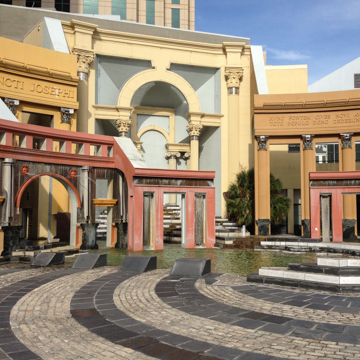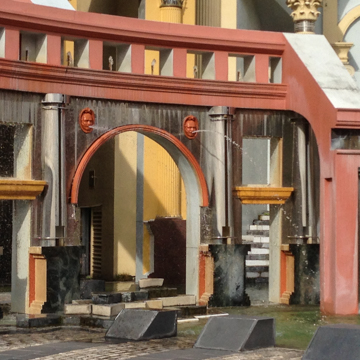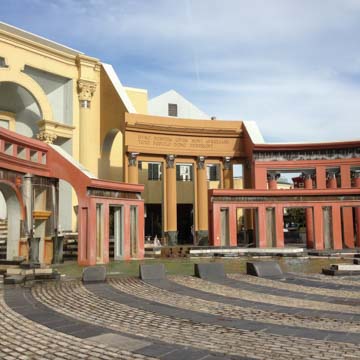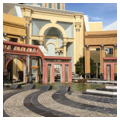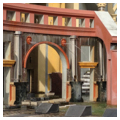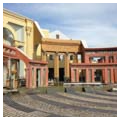Conceived as the centerpiece of a retail development and a site for festivals, especially for people of Italian heritage, the Piazza d’Italia originally included a temple-shaped pergola, a triumphal arch of painted stucco over a steel frame, a campanile (now demolished), and a set of curved colonnades as a backdrop to a pool surrounding an “island” in the shape of Italy. The pastel-colored columns of the colonnade each represent different classical orders. Water streams down the columns from the stainless-steel capitals of the front four colonnades into the pool and flows around the eighty-foot-long contoured island. Cartouches, one in the shape of Charles Moore’s head (added during construction without his knowledge) are set into the Doric colonnade and spout water. At night, neon lighting outlines the arches and columns. In an early scheme, the city of Rome was highlighted on the island of Italy, but following a review of the project by New Orleans’s Italian community, which was to a large extent of Sicilian origin, the island of Sicily was given proper prominence. The historical allusions and playfulness of the ensemble were considered an ultimate expression of Postmodernism. The Piazza nonetheless had critics, many of whom felt it was too frivolous and did not respect the city’s traditional architecture.
Soon after completion the Piazza was beset by problems. Because the surrounding area remained undeveloped, few people frequented it, and the absence of pedestrian traffic combined with the Piazza’s lack of shade and its rough cobblestone paving made the space uninviting. As well, the inexpensive materials of construction were easily degraded by New Orleans’s harsh climate; proposed renovations to adjacent buildings did not happen; and the City neglected its responsibility for maintenance and operation of the water system. By the late 1980s, the Piazza had disintegrated; the Postmodern icon became another piece of neglected urban fabric and the first Postmodern ruin. The campanile had been stripped to a rusting metal framework (it was eventually demolished), the triumphal arch was clumsily repainted in different colors, and the nooks and crannies formed by the arches and columns provided a refuge for the homeless. Now restored, even in a form less theatrical than originally intended, the Piazza is a colorful and cheerful oasis in the dense city grid, leased from the City and maintained by the adjacent Loew’s Hotel. However, it is fenced and gated and open to the pubic only sporadically.


